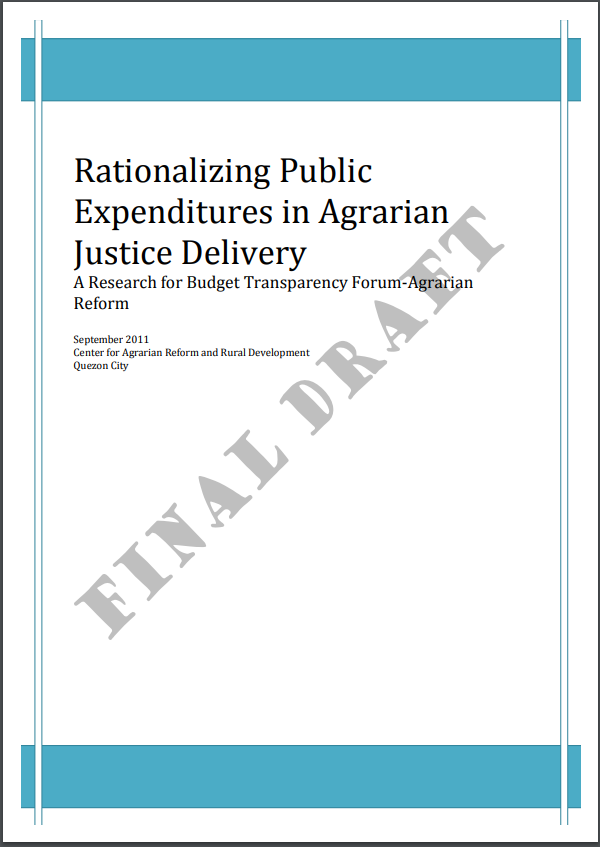![[OPINION] Is agrarian reform a dying issue?](/uploads/db/news/image/1531823991/newsimage.jpg)
AGRARIAN REFORM. As of June 2016, almost 600 000 hectares of agricultural land remain undistributed. File photo by Mau Victa/Rappler
The Center for Agrarian Reform and Rural Development (CARRD) has been involved in major agrarian reform campaigns staged after the 1986 EDSA Revolution. Together with other organizations and farmer groups, we've made a stand against the oppression experienced by landless farmers all over the country.
We maintained - and we still do - that land, being the primary driver of economic development in the rural areas, is a right of men and women whose bent backs and sweating brows nourished our children with food.
But times have changed. We know enough to acknowledge that mobilizations aren't what they used to be. In spite of valid reasons to picket, we see our numbers dwindle. We wanted to state - with full arrogance - that this is because there's nothing left to fight for.
Lots of our farmers have managed to improve their land tenure, improved their socio-economic conditions, sent their children to colleges and universities to become urban professionals and avoid the gruesome work on the land, and retired to become managers of the farms that they got under the Comprehensive Agrarian Reform Program (CARP).
But if this is the premise for all, then CARRD will be the first to let agrarian reform die with the first generation of peasants who fought sweat and blood for the land that they till. (READ: What if our farmers give up on us?)
But we know, as you do, that this is not the case.
CARP was introduced shortly after the 1986 EDSA uprising. Despite opposition, Republic Act 6657 or the Comprehensive Agrarian Reform Law (CARL) was passed in 1988. CARL went through a lot of amendments; the most recent of which was in 2009 through RA 9700 or the Comprehensive Agrarian Reform Program Extension with Reforms (CARPER).
Under CARPER, the issuance of Notices of Coverage (NOC) for new agrarian lands must be completed by June 30, 2014. By 2016, roughly 8.2 million hectares of land had been distributed to 5.4 million agrarian reform beneficiaries in the country.
The "deadline" for the issuance of NOC does not signify the end of CARP, although a lot of landlord-leaning institutions interpreted this as such. But the Constitution is also very clear on this matter. According to Article XIII, sections 4-6, the Constitution guarantees the just distribution of land, support to agriculture, and resettlement of farmers and farm workers in the State's agricultural estates. (READ: Completing land reform in PH to cost P98B)
Yet, as of June 2016, almost 600,000 hectares of agricultural land remain undistributed.
Major issues
Landowner resistance is one of the most well-known issues in agrarian reform. We know about high-profile cases of violence and constant threats against agrarian reform beneficiaries to keep them from occupying the land, or where land owners stall the land acquisition and distribution process through various methods, which, while not high-profile, are just as problematic.
Some of these methods include filing of cases against farmers and even Department of Agrarian Reform (DAR) personnel, legal measures to bog down the land acquisition and distribution in almost every step of the way, and subdividing their land to relatives to take advantage of the 5-hectare retention area, while not losing the land altogether.
Then there's the individualization of collective certificate of land ownership award (CLOA). These were issued during the 1990s to fast-track land distribution, especially in sugarcane plantations. However, while collective titles show the total area owned by farmers collectively, they don't delineate individual lots.
Not only does this create boundary disputes among agrarian reform beneficiaries, it spawns to inheritance and issues of conflicting claims. There are even cases when the collective titles don't have an annexed list of farmers, resulting to claims that cannot be easily validated.
Property rights cannot be altogether secured if the farmers are not able to complete paying their land amortization. Most of them have not even started. This is because, by policy, Landbank cannot receive amortization payments from landholdings with survey discrepancies, or in collectively titled landholdings, pending for subdivision.
Agrarian reform is uncertain in a federal context
The DAR convened the 2018 National Summit of CARP Stakeholders last January 25-26 in Clark, Pampanga. Acknowledging these issues, DAR expressed its commitment to ensure that inputs from the invited organizations would be incorporated in their strategic plan.
But the question is: how can the call for more aggressive CARP implementation fit within a federal context? If the implementation of agrarian reform will be through the states, as what can be assumed from the system of government being proposed, then agrarian reform may not be implemented at all in powerful landowner states.
The future of agrarian reform is unclear. While close coordination between CARP implementing agencies and stakeholders promises an effective method of case resolution, it can only go so far. With no end in sight for these issues, hopefully something positive will come out from the initiatives of the agrarian reform beneficiaries, civil society, and members of the government.- Rappler.com
Joe-Anna Marie Abelinde and Luis de la Rosa work in the Research and Advocacy Unit of the Center for Agrarian Reform and Rural Development. CARRD is a not-for-profit organization supporting agrarian reform beneficiary cooperatives in Batangas, Iloilo, and Capiz. It promotes farmers' access to productive resources and enable them to make informed decisions about environment-friendly, non-discriminatory, and sustainable livelihoods.



